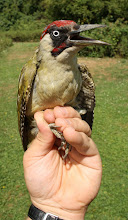Above: Lesser Spotted Woodpecker
It was a year with a number of highlights - 11 new species on the ringing list for SSNR, 3 birds ringed elsewhere caught here and 1 bird ringed here caught elsewhere.
Again, the weather played a part in being able to get out and in breeding success for the birds. Whitethroat, in particular, suffered badly from the rain (as I will show later).
In comparing 2011 and 2012, the overall totals do not give a truthful comparison. Overall, more effort went into ringing SSNR in 2012. This came in the form of longer ringing sessions, one or two more nets at times and as I get more proficient at targeting species, numbers of those species have gone up. As an example, Whitethroat numbers were down in 2012 because of poor breeding but Lesser Redpoll numbers jumped this autumn because I had more success with that species.
Total New: 533 Total Retrap: 469 Overall Total: 1002 New for Year: 621 No. of species: 37
2012 Highlights:
The new species were: Brambling (1), Mistle Thrush (1), Starling (3), Linnet (1), Common Redpoll (1), House Martin (1), Goldcrest (8), Jackdaw (1), Magpie (1), Nuthatch (1) & Lesser Spotted Woodpecker (1).
I won't add photographs of all the new species but here are a few of my favourites:
Above: A House Martin
Above: A Brambling
Above: A Mistle Thrush
The first controlled bird for this site came in February - it was a Chaffinch originally ringed near Little Fen, South Lopham, Norfolk on 23rd May 2010. Next, a Chiffchaff ringed at SSNR in July was controlled in Letchworth in late August.
And then in December, 2 foreign ringed birds turned up (my first foreign ones): a Blackcap with a Strasbourg ring and a week later, a Siskin with a Brussels ring. This data has been submitted to the BTO and I eagerly await the original ringing details.
Above: An adult female Siskin with a Brussels scheme ring on.
I have calculated the amount of effort gone into ringing sessions by counting the hours between first and last capture. This is therefore a minium number as the nets can be up for a while before and after first and last capture.
Total hours in 2012 = 244.25 (38 visits at an average of 6.5 hours per visit) compared to a total in 2011 = 181.25 (36 visits at an average of 5 hours per visit). Fewer new birds were ringed (533) compared to 2011 (693), so the overall total has a greater proportion of retraps.
As for the species:
Apart from Blue and Great Tits that come to the feeding station, Common Whitethroat is the most often ringed species for the site. 2011 was a very good breeding year with 118 birds ringed, but in comparison, 2012 was too wet for them and breeding was largely unsuccessful. Only 6 juveniles were ringed (of 18 new birds) compared to 86 juveniles in 2011 (of 118 new birds). Effort during April to August was 14 visits in 2012 compared to 17 in 2011 so this works out very similar when taking average visit length into account.
More Blackbirds and Song Thrushes were ringed in 2012 as more effort has gone into catching these (apples have worked well).
Despite more effort, fewer Goldfinch have been visiting the feeding station (food has been available on the same basis as 2011).
No Meadow Pipits were caught this year. I did try once, but the conditions weren't ideal. I had two successful attempts in 2011.
No Grasshopper Warblers were ringed this year as none were present in my normal ringing area. At least 2 reeling males were elsewhere on site. 2011 may turn out to have been exceptional as weather conditions in April when they arrived were ideal, whereas 2012 weather was far from ideal. Additionally, some may have, of course, not made it through the winter (where ever they spend it!).
Lastly, longevity records for the site were broken this year. There is nothing spectacular in these and at this stage of the project, it is to be expected. Here are a few selections:
A Great Spotted Woodpecker at 1 year, 348 days.
A Whitethroat at 2 years and 5 days
A Long Tailed Tit at 2 years and 80 days
A Blue Tit at 2 years 26 days
A Great Tit at 2 years 105 days
A Chaffinch at 1 year, 279 days
My first ringing session for the year produced 5 new birds and 5 retraps. A slow start! As I am writing this, I am looking out the window and it is snowing (as it has been all day) so no ringing has been done this weekend). Fingers crossed for next weekend (and the rest of the year!).













